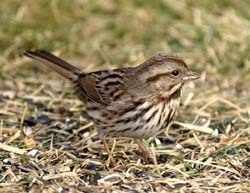
Fun Facts About Song Sparrows
- A rich, russet-and-gray bird with bold streaks down its white chest, the Song Sparrow is one of the most familiar North American sparrows. Don’t let the bewildering variety of regional differences this bird shows across North America deter you: it’s one of the first species you should suspect if you see a streaky sparrow in an open, shrubby, or wet area. If it perches on a low shrub, leans back, and sings a stuttering, clattering song, so much the better.
- In spring and summer, Song Sparrows are one of the most conspicuous of all sparrows. Males sing often, perching around eye level on exposed branches. Also watch for Song Sparrows moving along wetland edges, ducking into dense, low vegetation after short bursts of their distinctive, tail-pumping flight.
- Song Sparrows eat many insects and other invertebrates in the summer, as well as seeds and fruits all year round. Prey include weevils, leaf beetles, ground beetles, caterpillars, dragonflies, grasshoppers, midges, craneflies, spiders, snails, and earthworms. Plant foods include buckwheat, ragweed, clover, sunflower, wheat, rice, blackberries, blueberries, strawberries, raspberries, mulberries, and wild cherries.
- Song Sparrow pairs search for nest sites together. Nest sites are usually hidden in grasses or weeds, sometimes placed on the ground and occasionally as high as 15 feet; often near water. Not afraid of human habitation, Sparrows may nest close to houses, in flower beds. Song Sparrows seem to have a clear idea of what makes a good nest. Field researchers working for many years on the same parcels of land have noticed that some choice spots – the base of a rose bush, or a particular hollow under a hummock of grass, for example – get used over and over again, even when entirely new birds take over the territory.
- Song Sparrows walk or hop on the ground and flit or hop through branches, grass, and weeds. Song Sparrows stay low and forage secretively, but males come to exposed perches, including limbs of small trees, to sing. Courting birds fly together, fluttering their wings, with tails cocked up and legs dangling. Song Sparrows are primarily monogamous, but up to 20 percent of all Song Sparrows sire young with multiple mates each breeding season. In fall, juvenile Song Sparrows may band together in loose flocks around berry trees or water sources. Flight is direct and low on broad, rounded wings. Often flies only short distances between perches or to cover, characteristically pumping the tail downward as it flies.
- The oldest known Song Sparrow was at least 11 years, 4 months old when it was recaptured and rereleased during banding operations in Colorado.

